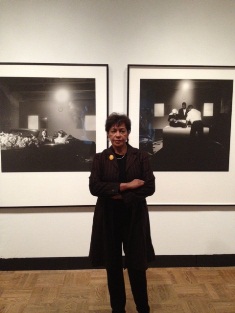 Carrie Mae Weems |
As a youth, Carrie Mae Weems remembers protesting for civil rights and an end to the Vietnam War in front of the Portland Art Museum. Now, the museum houses her latest exhibit.
"We were beat up and clubbed and tear gassed," says Weems. "As a young girl, walking up and down these streets and demonstrating in front of this museum, I never thought that I'd be in this museum showing any body of work."
Weems' exhibit "Three Decades of Photography and Video" opened on Feb. 2 and is running through Mar. 19. The collection of over 200 photos and videos seeks to engage audiences in complex discussions on the Black experience.
Weems became interested in the arts while growing up in Portland. There were a number of musicians in her family but the only one visual artist was her aunt Katie.
She was heavily influenced by artists who had moved to Portland from the east coast and began getting involved in street performance, dance and radical theater when she was around 15 or 16 years old.
Weems says her interest in social justice came from her relationship with her father.
"Early on my father influenced how I looked at race, class and gender because my father was so eloquent and so hip," she says. "He gave us a great sense of the importance of our own humanity and the insistence that we had a right to be who we were and that there's no one better than you. That sense of coming from a family like that, with a father that taught me from the earliest age I can remember, had a profound impact on how I thought about life."
Although her work is internationally recognized for exploring subjects like race, gender and class, Weems doesn't want her art to be reduced to "race relations."
She insists that Black subjects can be used to express more than just the idea of Blackness, as evidenced by two of her series, "Family Pictures" and "The Kitchen." When we see white actors and actresses in popular media, we automatically assume they represent more than whiteness, she says. By making her subjects more three dimensional, she aims to challenge power dynamics.
"I want my subjects to stand in for more than themselves -- shifting the balances of power, engaging the audiences in a new way, asking them to think about not just the work but themselves in a new way," says Weems. "To the extent that you can get people to move beyond their own narrow confines and to a new dimension, is to the extent that work can be powerful and to that (extent) it can change your life."
Power is a recurring theme in Weems' work. She likes to unpack it, both in terms of individual relationships and on a larger societal level.
For example, in her series "From Here I Saw What Happened and I Cried," Weems looks at power in photography. Specifically, she looks at the three intertwining stories of the history of photography, how Blacks have been depicted historically and the history of Blacks in America, in general.
One particular photo of an elderly Black man reads, "Descending the throne you became footsoldier & cook." Another photo of a Black woman reads, "You became mammie, mother & then, yes, confidant – ha."
Weems says the questions of who holds the power is especially profound in that series.
As she reflects on both her work and her days protesting, Weems notes that she is on a journey to understand the possibilities of life and this historical moment. In particular, she is interested in how this generation of youth engages with social justice, noting that her generation's radicalism was sparked by the turbulent events of the 60s.
"What made us possible were all the assassinations that took place," she says. "The assassination of Kennedy. The assassination of Martin. The assassination of Malcolm. That's what made you and I sitting at this table right now possible."






















































































































































































































































































































